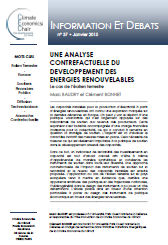
THE PARIS CLIMATE AGREEMENT: LET THE NEGOTIATIONS BEGIN!
by Christian de PERTHUIS
Adopted in plenary session on 12 December 2015 by the 196 Parties meeting under the auspices of the United Nations, the Paris Agreement was a success for French diplomacy. Twenty-five years after the start of the negotiations, the international community has established a new framework for applying the 1992 Climate Convention, with a view to accelerating cooperation to combat climate disruption. Can the diplomatic success in Paris end the “slow race” (Dahan and Aykut (2015)) or “waiting game” (Tirole and Gollier (2015)) of negotiations?
The Agreement’s wager is that the new framework for cooperation will generate virtuous competition in terms of climate policies, which will penalize the “lowest bidder” and reward the “highest bidder”. Such a dynamic would gradually increase the ambition of the contributions submitted by each country to the common basket and thereby produce an emissions trajectory limiting the risk of average warming to 2°C or even 1.5°C. The intention is laudable. In the absence of agreement on the instruments to be used, its implementation is contingent on the willingness of governments, the proactivity of stakeholders and the pressure exerted by civil society.
To end the “waiting game”, it is essential to agree on the instruments deployed. Our contribution focuses solely on economic and financial instruments. It advocates greater coordination among nascent carbon pricing instruments in order to reduce the cost of their fragmentation and to remove disincentives. It calls for the establishment of two ad hoc instruments: a universal excise duty, levied upstream of production chains, proportionately to the CO2 content of the various fossil fuels; and a transfer mechanism following a rule of “bonus-malus”(reward-penalty) rule calculated from the emissions per capita to encourage developing countries to join the common system of measurement and verification.
